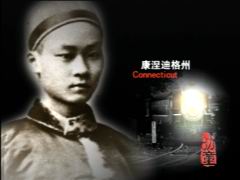Source: CCTV.com
08-14-2006 15:47

On August 11, 1872, the first group of students set sail from Shanghai. Their parents had already signed a contract with the government for a term of 15 years. The contract stated that upon graduation the students must return to serve the government; they were forbidden to work in America and, if ill-fate such as accident or illness, should befall them on the way to or in America, the family should be accountable for it themselves.
Although the selection rules stipulated that the selection entailed no discrimination between Manchurians and Han Chinese, among the 120 students chosen, not a single one was a Manchurian.
“.... I paid my last respects to my mother in the conventional way. I did not embrace her hand kiss her. O no! that would have been un-Chinese and undignified. What I actually did was to bow my head four times to the ground upon my knees. She tried to appear cheerful, but I could see that her eyes were moistened with tears.” [from When I was a Boy in China]
On August 11, 1872, the first detachment of boy students sent by the Qing Empire set out from Shanghai, embarking on their 15-year-long program of overseas study.
The vessel that carried the young students to America relied on the giant steam-driven wheels on both sides to move, hence the name “paddle-wheeler”.
The boy students took a different route from Rong Hong who sailed to America 20 years ago. From Shanghai to America, they no longer needed to spend 90 days on the westward route, negotiating the Cape of Good Hope on their way. The newly invented steamboat fared east across the Pacific until they reached the west coast of America. The journey took only 25 days.
Their first time away from home, the boy students were exhilarated. Yet when the journey on the surging billows started, it was soon accompanied by the cries from the cabin. Qi Zhaoxi was the official escorting the delegation. He detailed the whole journey in his account, later published as ‘Diary of Travels in America’. The book promises its current day readers to relive a trans-oceanic voyage of more than a century ago.
After a dozen days, the adults were still suffering sea-sickness that left them like drunkards, yet the boys were capering around when the storms came, with no fear or tear.
But when they had covered half the journey, Qi Zhaoxi said while the teachers still wanted Cantonese food, all the kids had fallen in love with Western food.
When the first group of boy students were still on their way in mid-Pacific, the New York Times had already reported on their expected arrival.
Half a year earlier, Frederick Low, then the American envoy to China wrote to the State Secretary of the U.S. Mr. Fish, ‘when passing through Tien-tsin, I called upon Li Hong Zhang, the governor-general. I was informed of a project of sending a number of young men to the United States to be educated. The viceroy said that he would esteem it a special favor if I would inform my government of the matter; and if I would use my influence to facilitate their reception into the proper schools.’
In the dossier exchange between the Qing Emperor and the American President, we can see why China sent students to America rather than to one of the European powers at that time.
As was recorded, the White House interpreted this measure of the Qing Court as a progressive move by the ancient kingdom. The Qing had begun to stop excluding foreigners in order to sustain its secluded empire, realizing that competition with the West could’t do without knowledge of the West.
On September, 12, 1872, the ship with Chinese students was about to arrive in Los Angeles. Qi Zhaoxi recorded in his diary ‘after lunch I opened the trunk to get the apparel for the students to wear in America. We had to show Los Angeles the glory of the Great Qing Empire.’

